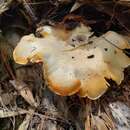pms
nòm ant ël fil


Pleurotus opuntiae is a species of Agaricales fungus that grows in the semi-arid climate of central Mexico[1] and in New Zealand,[2] whose mushroom is edible and considered a delicacy in the cuisine of indigenous peoples of Mexico. It is known as hongo de maguey común in Mexican Spanish, seta de chumbera/nopal in Peninsular Spanish, and kjoo'wada in Otomi language.[3] Phylogenetic research has shown that while it belongs to P. djamor-cornucopiae clade, it forms its own intersterility group,[4] but it has also been claimed to be genetically inter-incompatible with P. australis, P. ostreatus (extra-limital), P. pulmonarius and P. purpureo-olivaceus of New Zealand.[2]
P. opuntiae fruits gregariously in groups of several specimens on dead remains of the plant Opuntia megacantha, from which the binomial name of the fungus derives. They are beige or cream in color. Its gills are very decurrent and its cap, from 1 to 6 centimetres (1⁄2 to 2+1⁄4 in) in diameter, is quite flat and funnel-shaped, slightly rolled at the edges. It has either a very short stipe, or often basically nonexistent one.[5]
Pleurotus opuntiae is a species of Agaricales fungus that grows in the semi-arid climate of central Mexico and in New Zealand, whose mushroom is edible and considered a delicacy in the cuisine of indigenous peoples of Mexico. It is known as hongo de maguey común in Mexican Spanish, seta de chumbera/nopal in Peninsular Spanish, and kjoo'wada in Otomi language. Phylogenetic research has shown that while it belongs to P. djamor-cornucopiae clade, it forms its own intersterility group, but it has also been claimed to be genetically inter-incompatible with P. australis, P. ostreatus (extra-limital), P. pulmonarius and P. purpureo-olivaceus of New Zealand.
El hongo de maguey común (MÉX) o seta de chumbera o de nopal (ESP) (Pleurotus opuntiae) es una especie de hongo agarical que crece en las zonas semiáridas del centro de México,[1] así como en la cuenca mediterránea, y cuya seta es comestible, considerada un manjar en la gastronomía mexicana indígena. Los otomíes lo conocen como kjoo'wada.[2]
Este hongo fructifica de manera gregaria en grupos de varios ejemplares sobre restos muertos de la planta Opuntia megacantha, llamado en España chumbera y en México maguey o nopal blanco, de ahí el nombre del hongo. Son de color beige o crema. Sus láminas son muy decurrentes y su sombrero, de 1 a 6 cm de diámetro, es bastante plano y con forma de embudo, ligeramente enrollado por los bordes. Tiene un pie muy corto, a menudo ni tiene.[3]
El hongo de maguey común (MÉX) o seta de chumbera o de nopal (ESP) (Pleurotus opuntiae) es una especie de hongo agarical que crece en las zonas semiáridas del centro de México, así como en la cuenca mediterránea, y cuya seta es comestible, considerada un manjar en la gastronomía mexicana indígena. Los otomíes lo conocen como kjoo'wada.